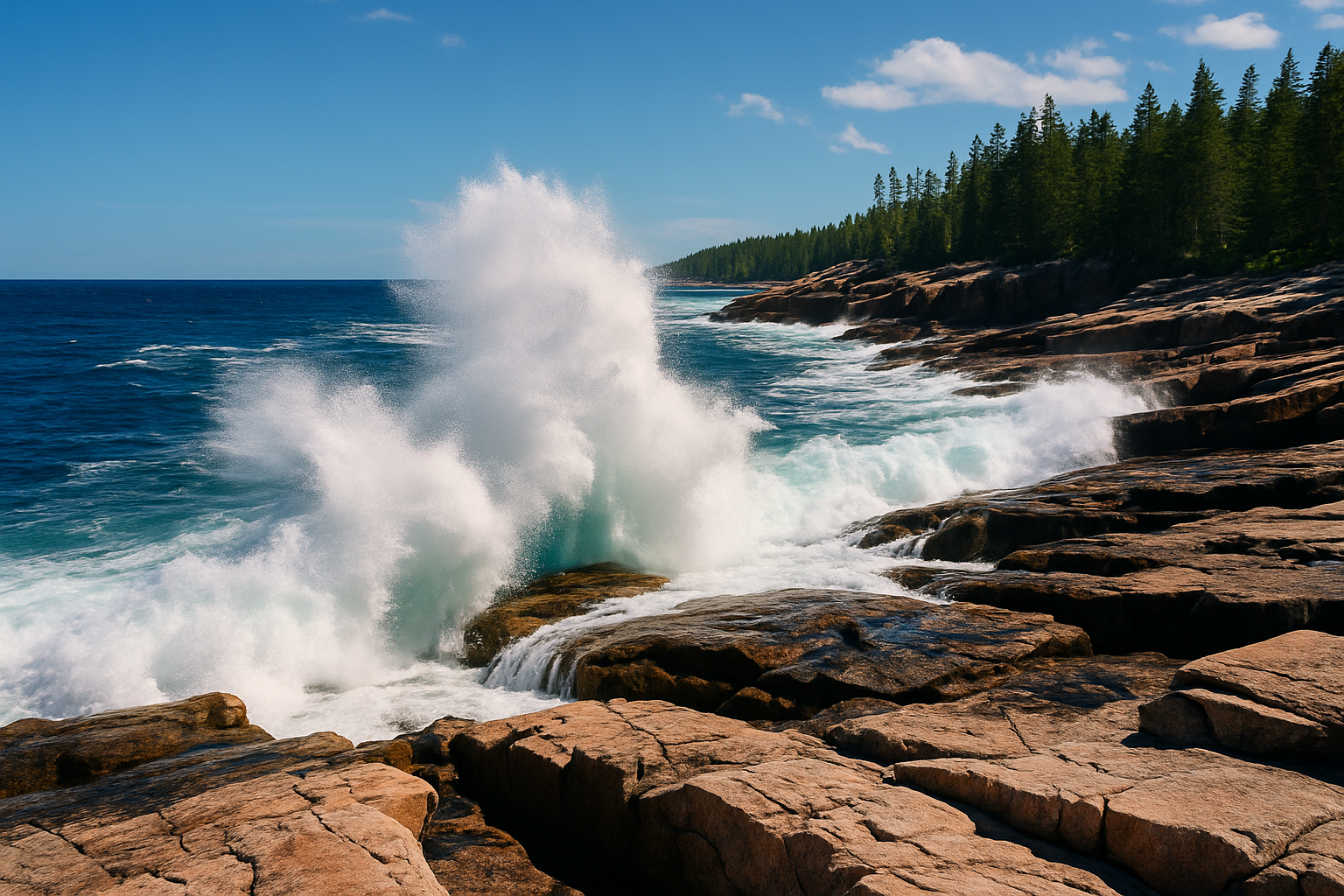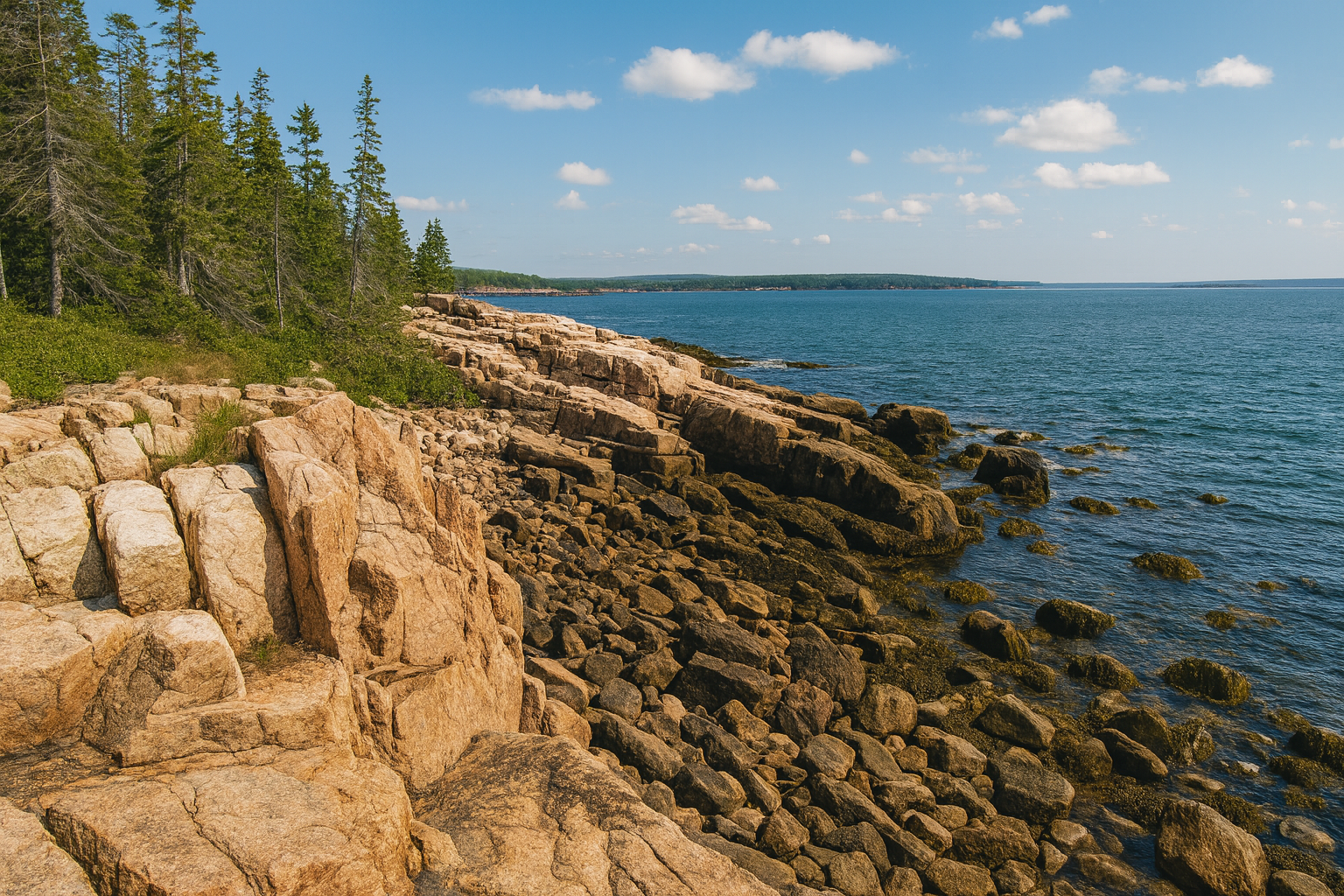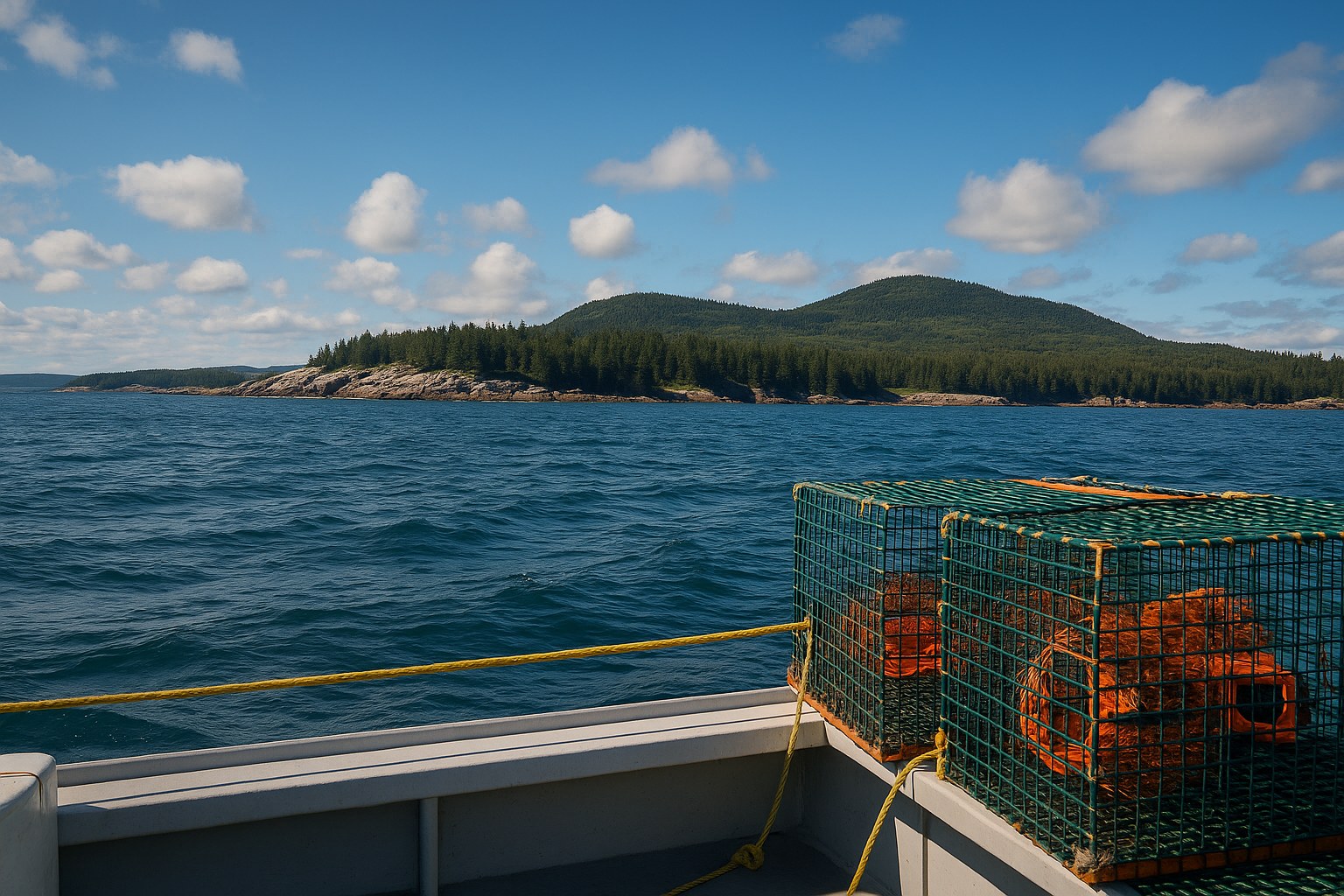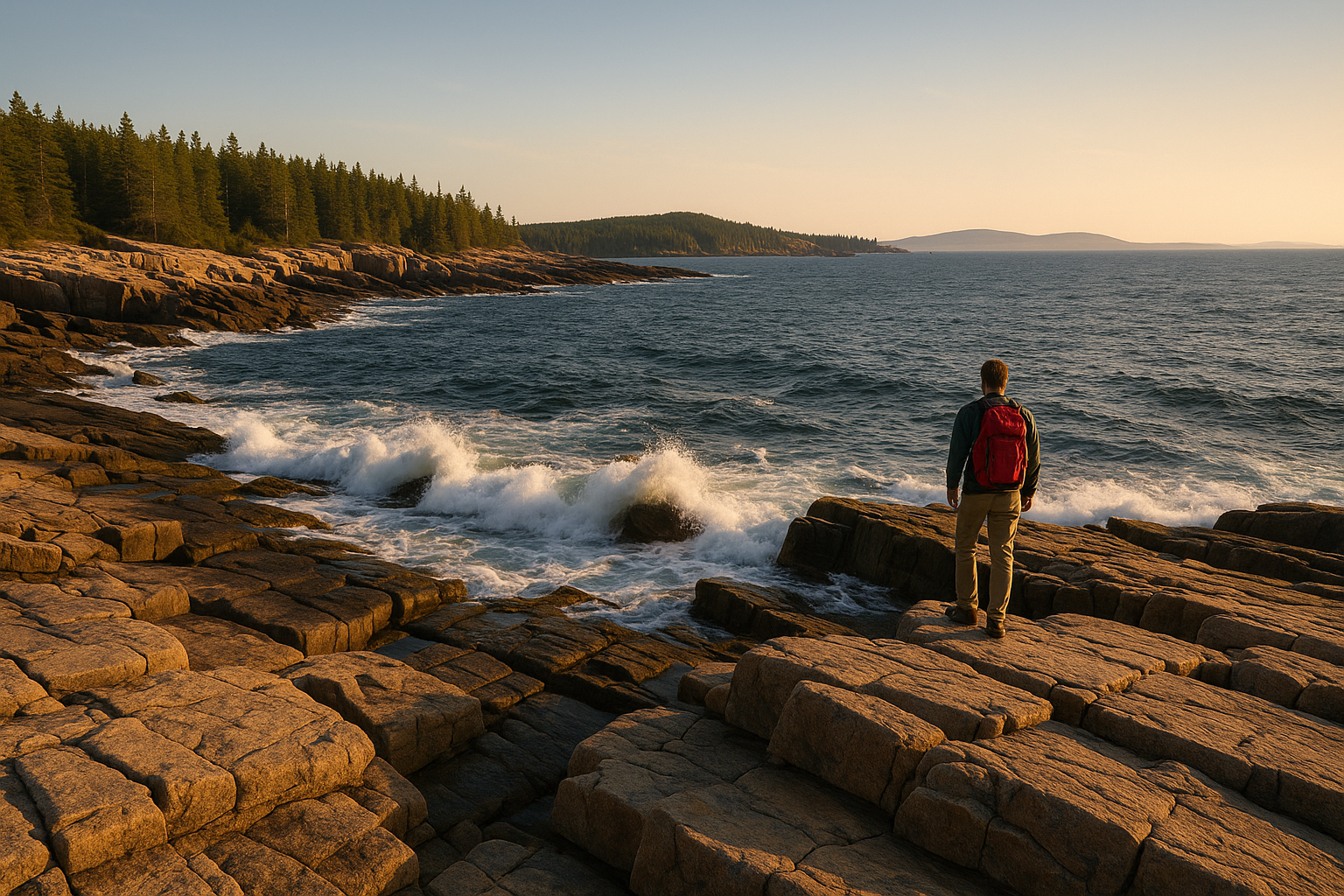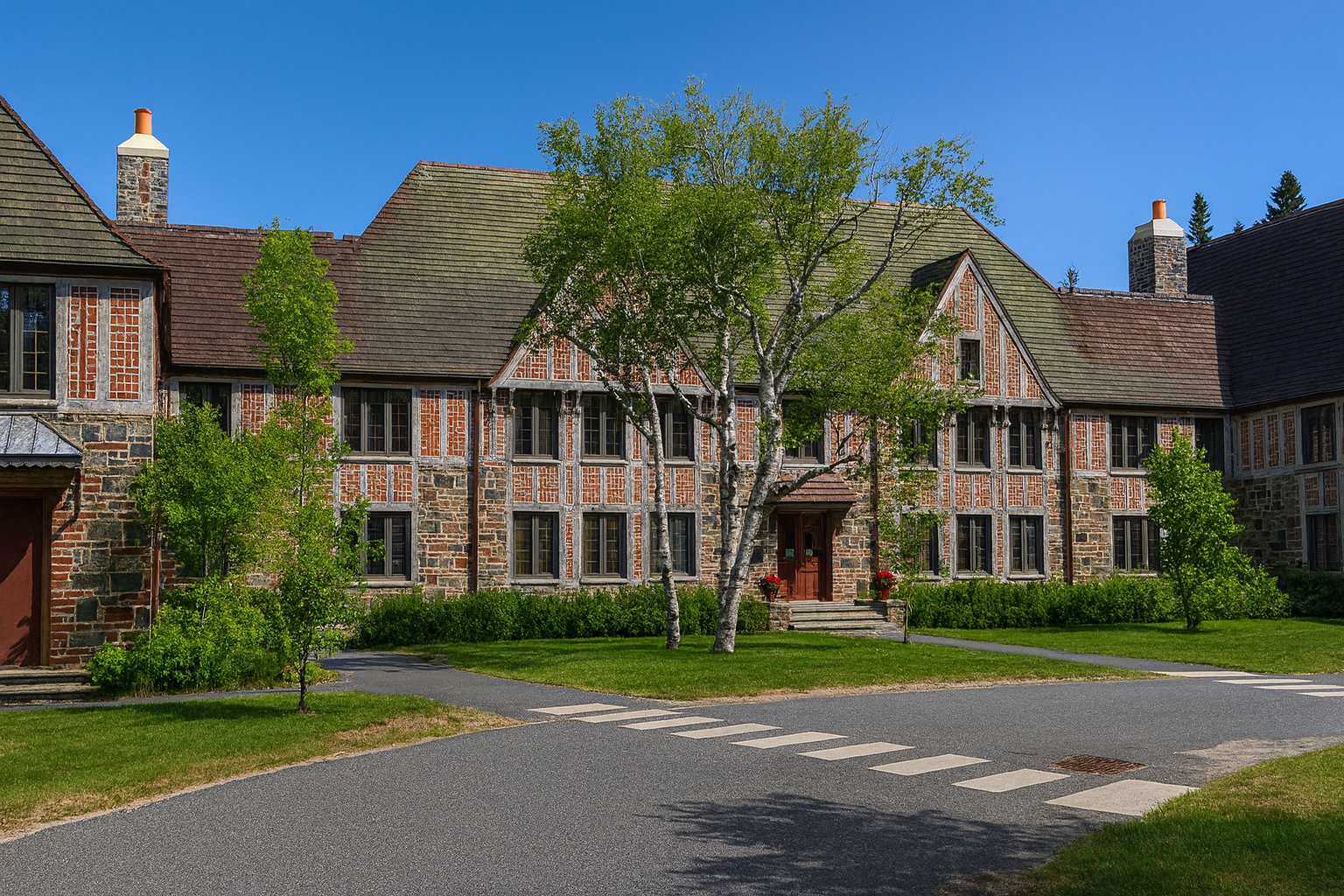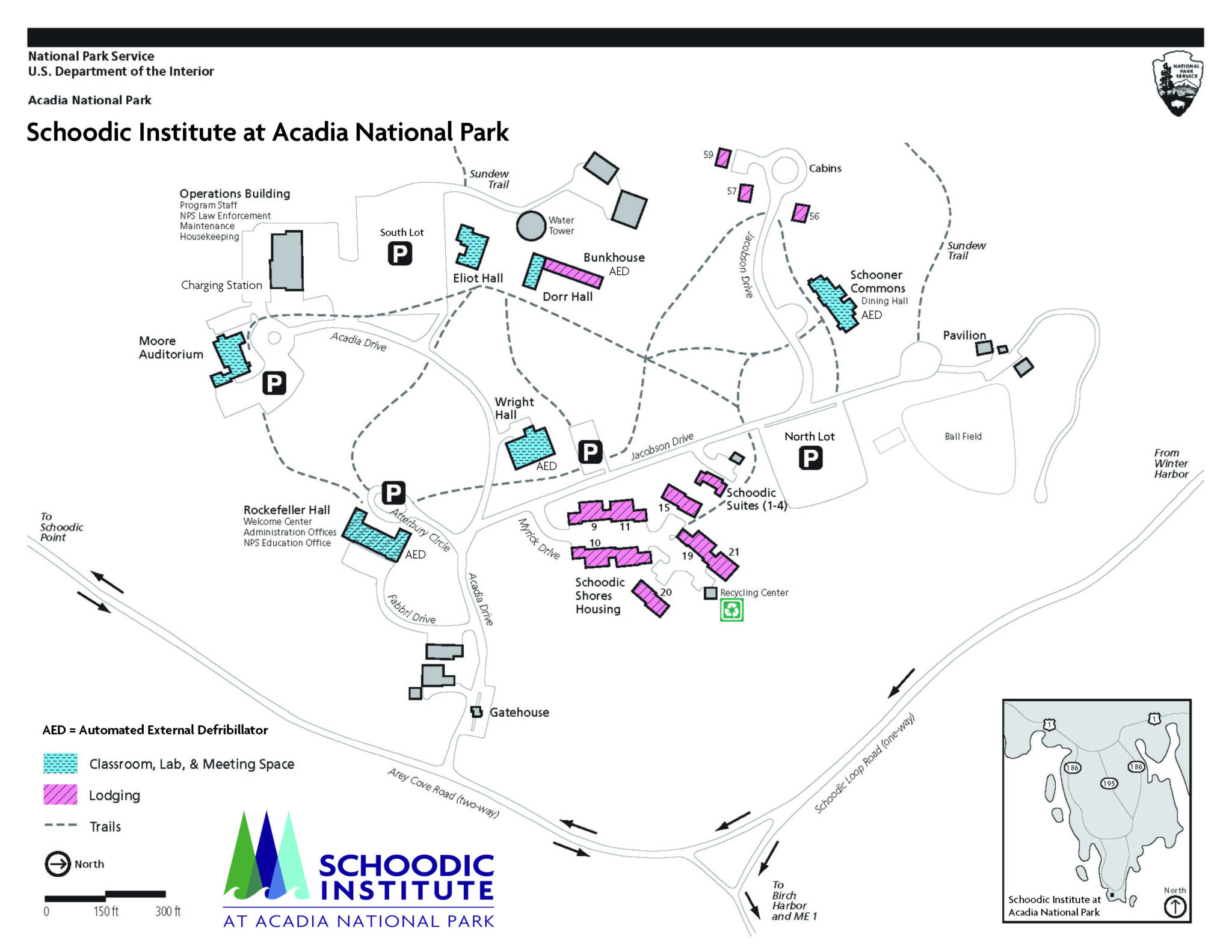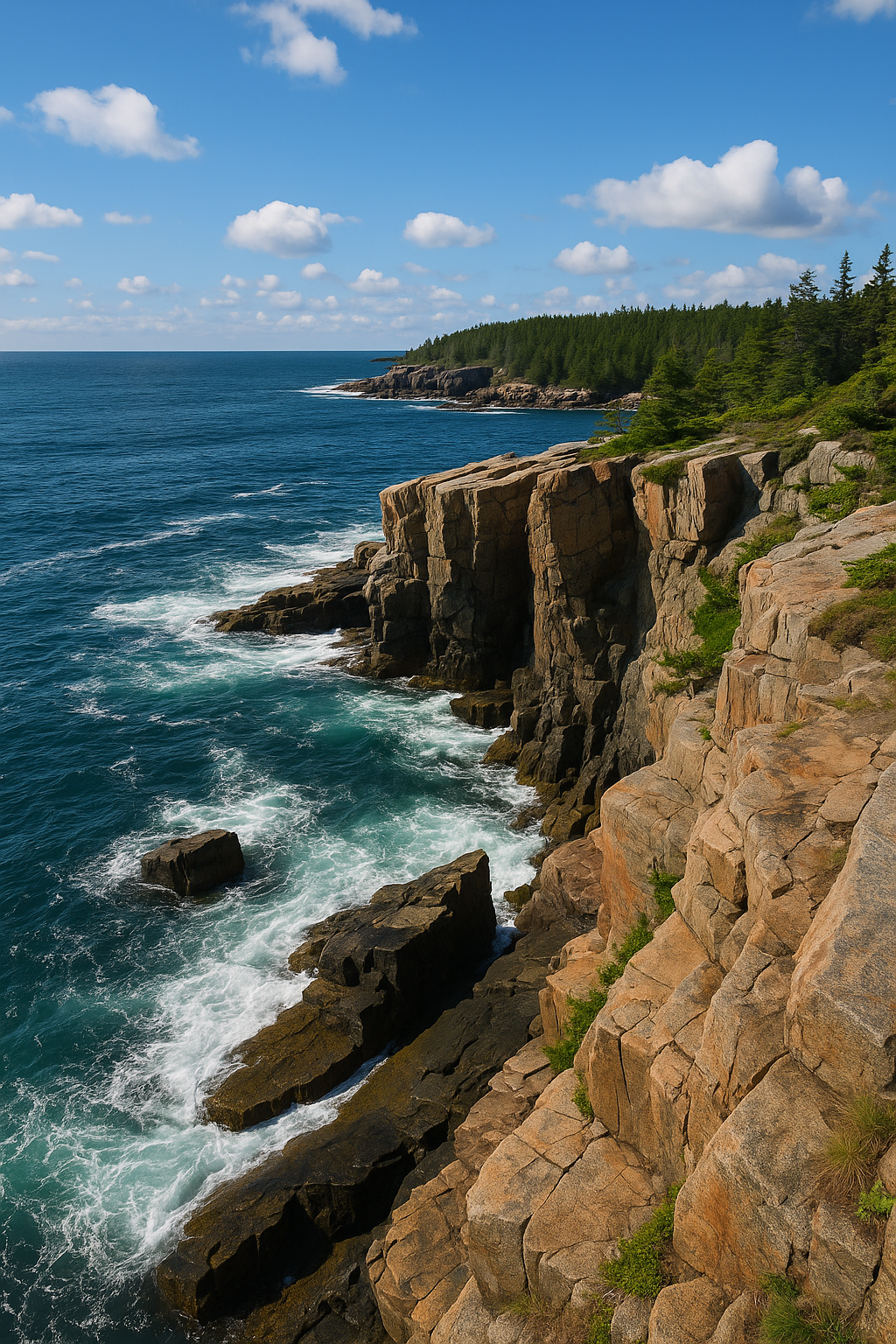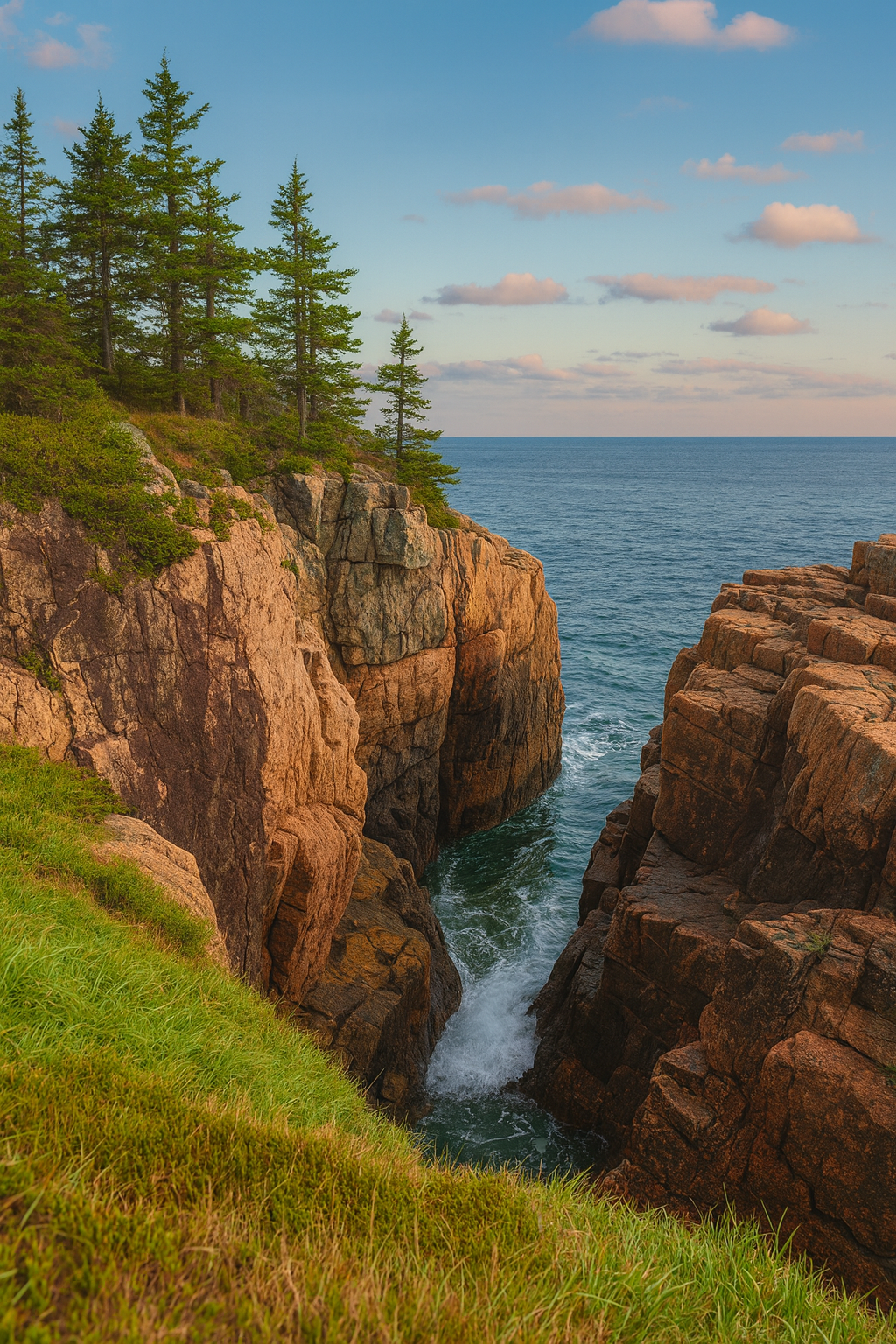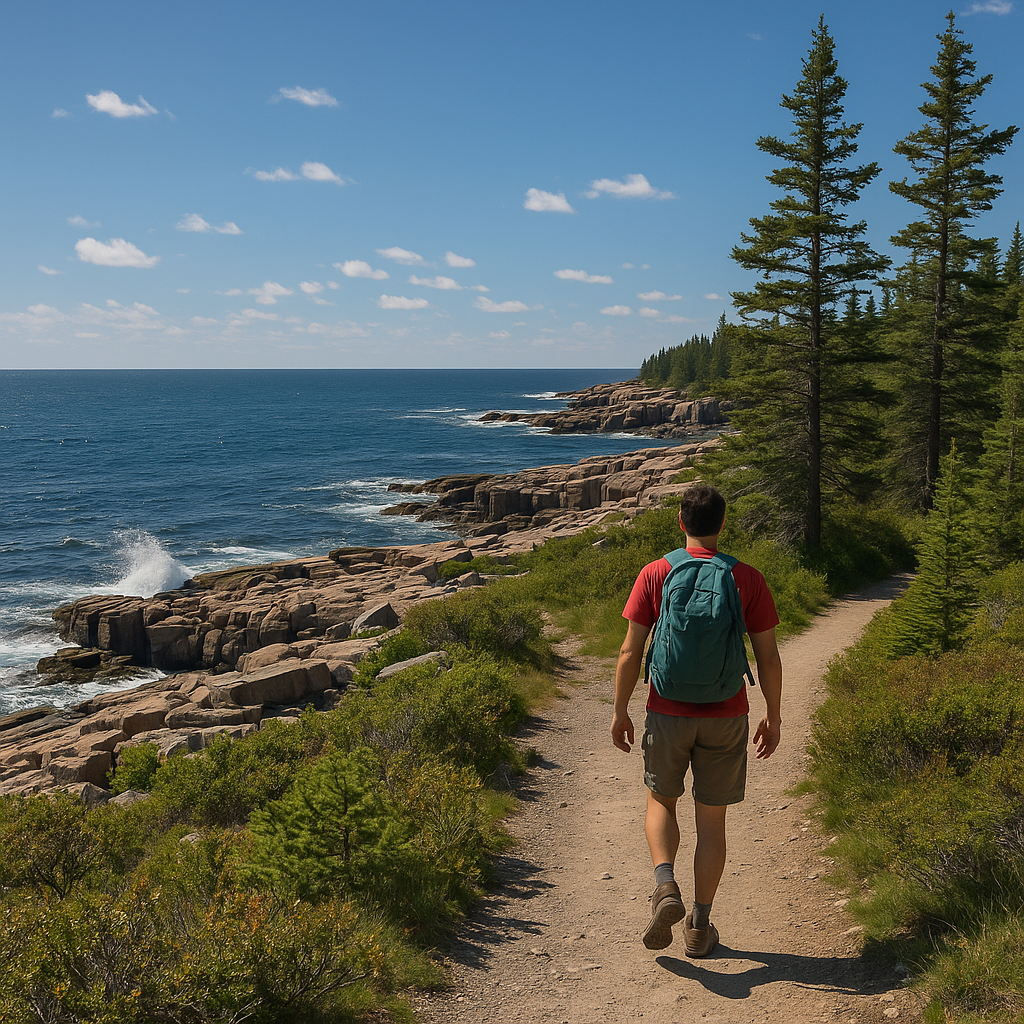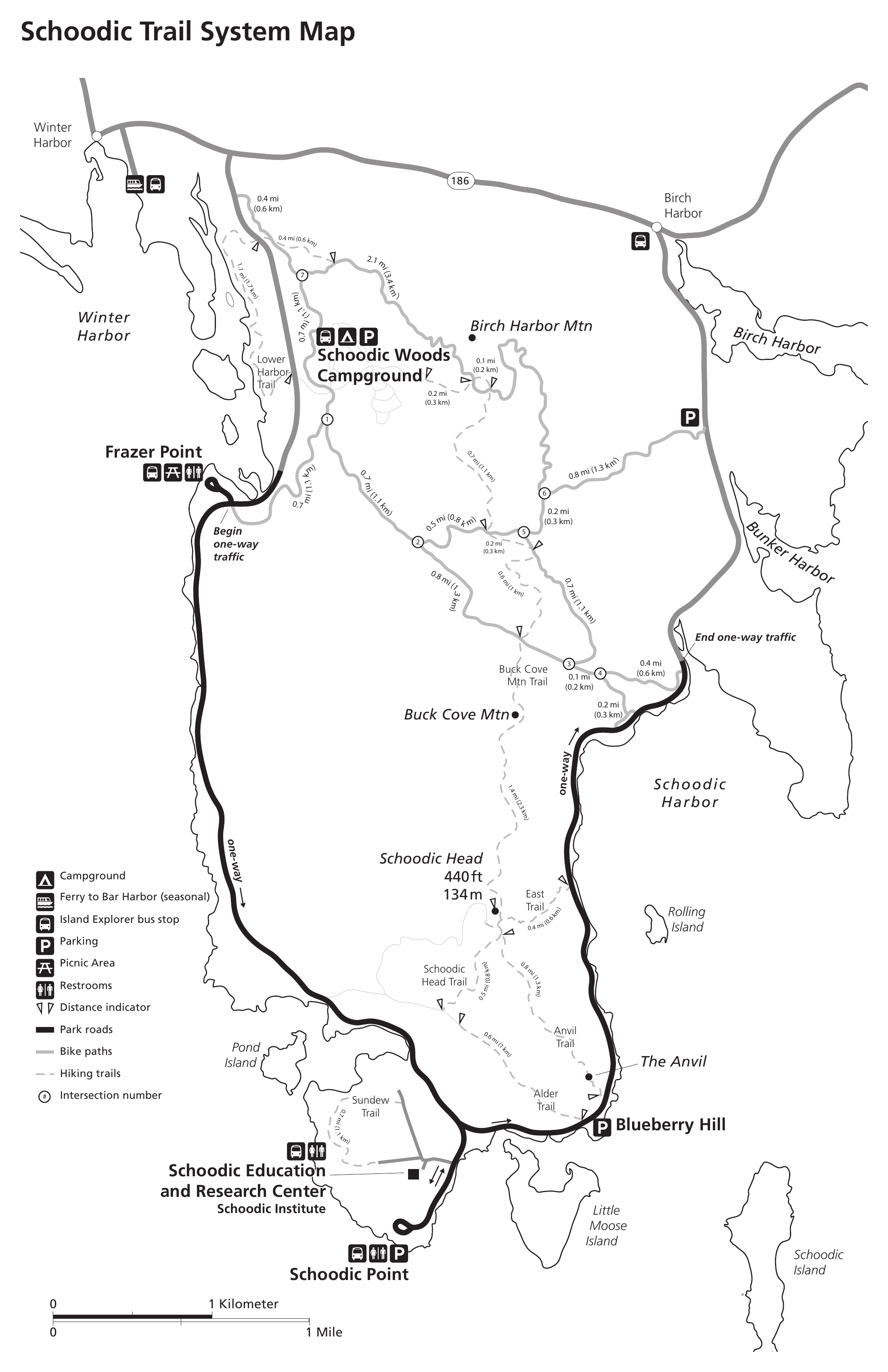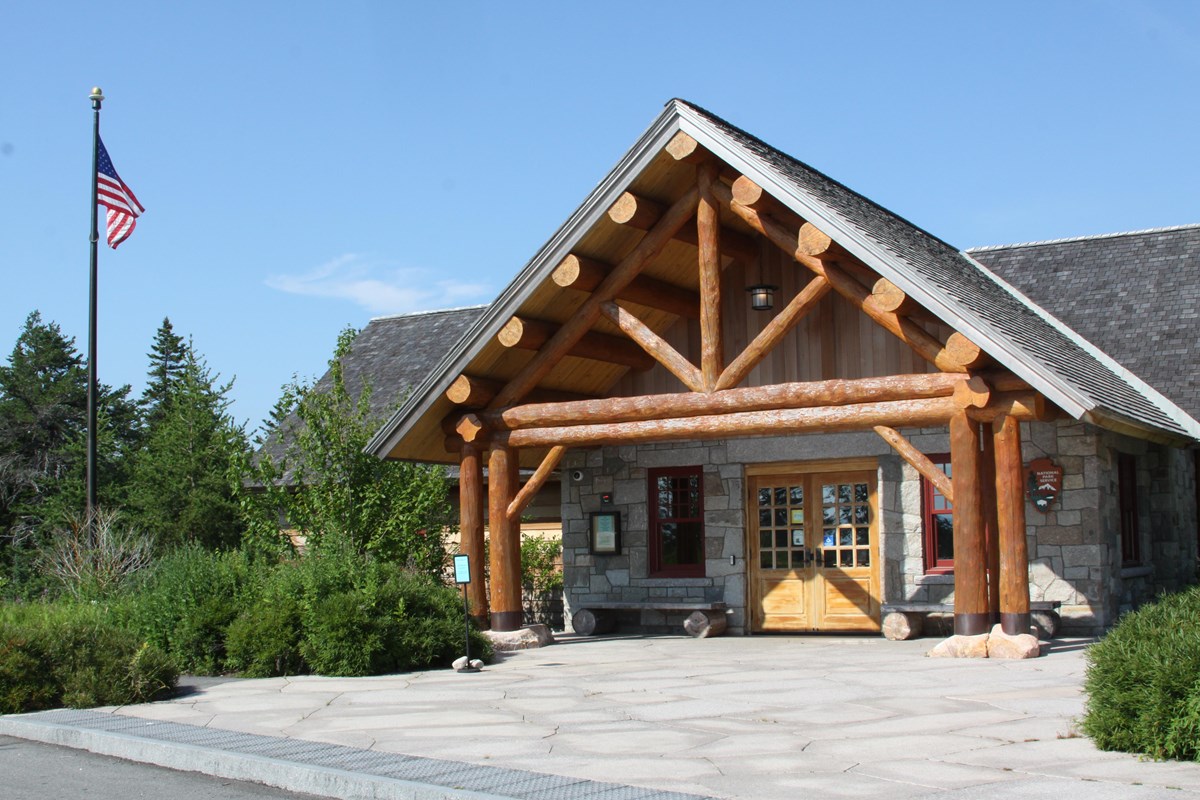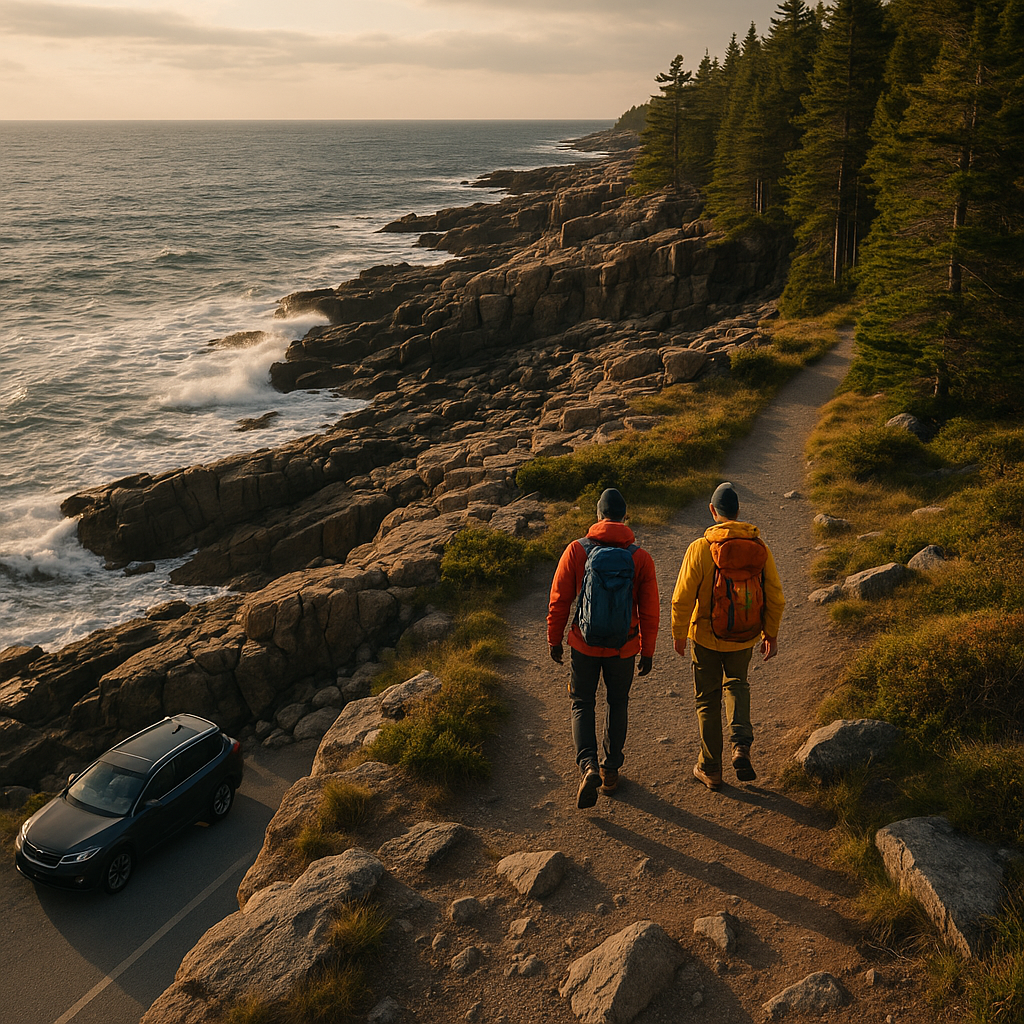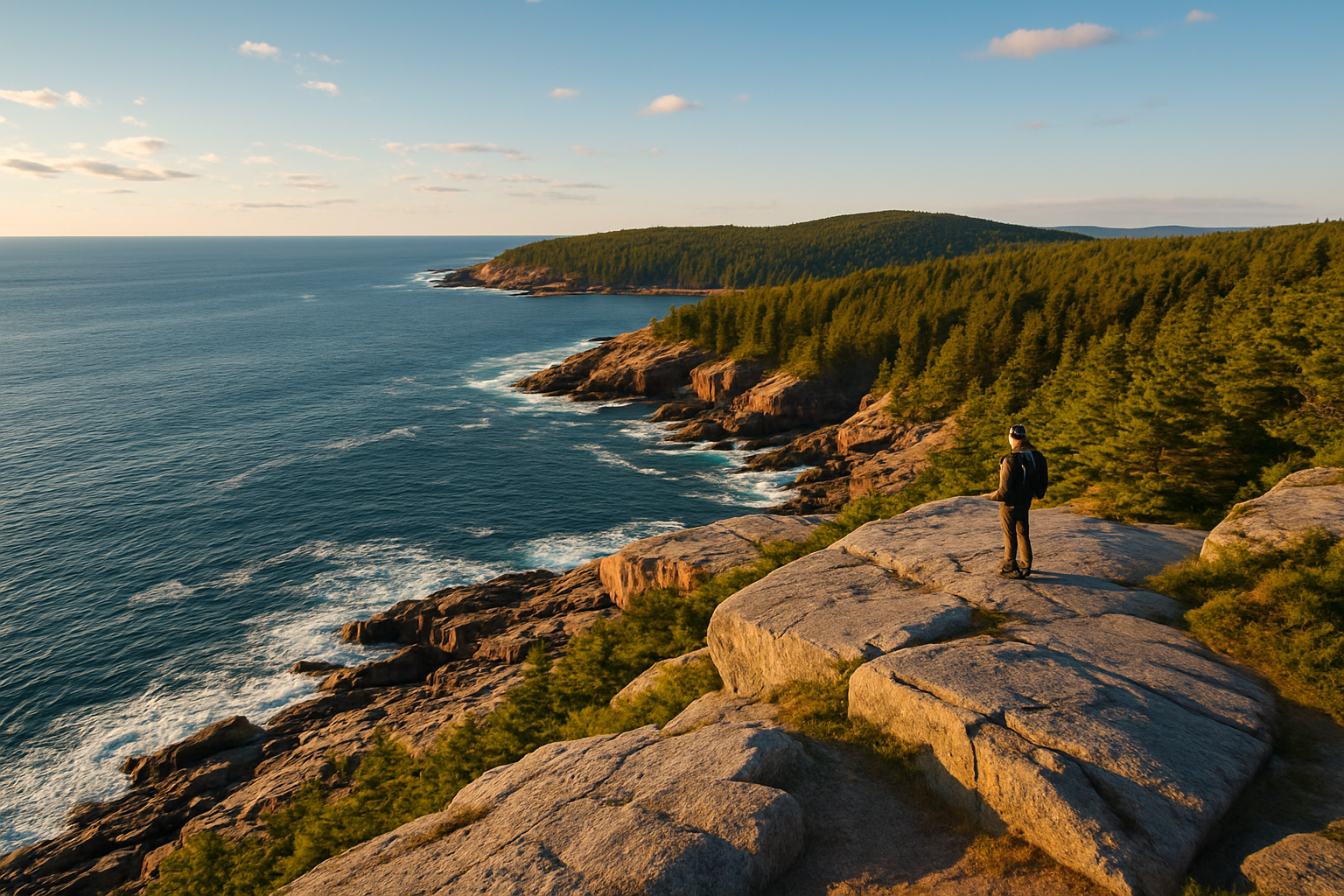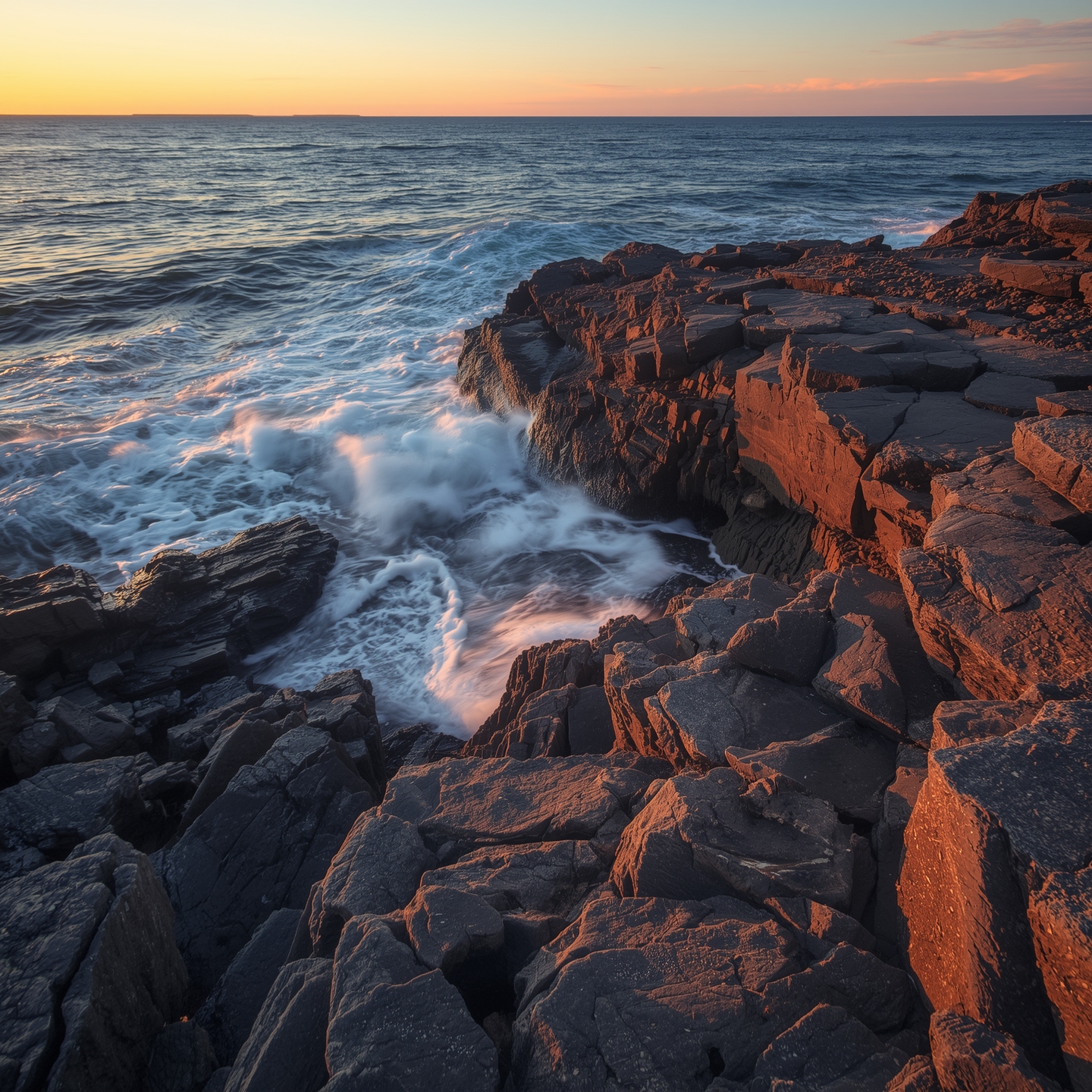Schoodic Peninsula Acadia National Park
Discover the Wild Beauty of Schoodic Peninsula Acadia National Park
The Schoodic Peninsula Acadia National Park is Acadia’s hidden mainland gem. Rugged granite cliffs, pounding surf, and quiet forests make it a dramatic yet peaceful escape from the busier trails of Mount Desert Island. With fewer crowds and some of the park’s most striking coastal scenery, Schoodic reveals Acadia’s wilder, quieter side.
While most visitors to Acadia National Park spend their time exploring the trails and carriage roads of Mount Desert Island, just across Frenchman Bay lies a hidden treasure: the Schoodic Peninsula Acadia National Park. This section of the park is unique — it’s the only part located on the mainland — and stepping onto it feels like entering a different world altogether.
Here, the landscape is shaped by rugged granite headlands that jut into the Atlantic, where waves crash with thunderous power and send white spray high into the air. Between the rocky points, stretches of quiet forest offer shaded paths and glimpses of wildlife, giving the peninsula a rhythm that is both wild and deeply peaceful.
What makes Schoodic so appealing is the way it contrasts with Acadia’s busier areas. With far fewer crowds, visitors can truly savor the dramatic scenery without distraction. Scenic drives hug the coastline, revealing panoramic views of Frenchman Bay and the distant peaks of Mount Desert Island, while tucked-away trails lead to secluded coves where the sound of the surf is your only company.
For those willing to venture beyond the park’s most famous spots, the Schoodic Peninsula offers a chance to see Acadia’s quieter side — raw, dramatic, and unforgettable.
• Only part of Acadia National Park located on the mainland
• Famous for rugged granite cliffs and pounding Atlantic surf
• 6-mile one-way scenic drive with pullouts for coastal views
• Trails lead to coves, headlands, and spruce–fir forests
• Panoramic views of Frenchman Bay and Mount Desert Island
• Far fewer crowds than Mount Desert Island — a quieter escape
• Perfect for photography, birdwatching, and storm-watching
Schoodic Peninsula Acadia National Park - Different Side of Acadia
The Schoodic Peninsula Acadia National Park stretches boldly into the Atlantic, about an hour’s drive from Bar Harbor. Unlike the busy Park Loop Road on Mount Desert Island, the pace here feels slower, more deliberate, and the landscape more untamed. Waves thunder against the granite ledges, seabirds wheel overhead, and the rhythm of nearby fishing villages reminds you that this is both a natural and cultural landscape. For travelers hoping to step away from the bustle without leaving Acadia behind, Schoodic Peninsula strikes the perfect balance — wild yet welcoming, remote yet refreshingly accessible.
Because it is less visited, Schoodic offers something increasingly rare in Acadia National Park: solitude. You can wander the shoreline for half a mile and see no one at all. The air smells of pine and salt spray, the horizon glows with soft Maine light, and every tide feels like a new performance by the sea. The granite here is sculpted into shelves and ledges that invite quiet exploration — the kind of place where you might sit for an hour and watch a lobster boat pass, or see harbor seals rise and disappear with the waves.
The Schoodic Peninsula Acadia National Park experience is deeply shaped by its contrast to Mount Desert Island. Instead of bustling trailheads and crowded viewpoints, you’ll find winding forest roads, unmarked coves, and locals who still haul traps or mend nets along the shore. Artists and photographers love the peninsula’s raw beauty — its open ocean views, brooding skies, and ever-changing light. Hikers can explore a network of coastal and forest trails, from easy loops to the steeper climb up Schoodic Head, while cyclists follow the scenic Schoodic Loop Road for sweeping coastal panoramas.
Many visitors describe Schoodic as “Acadia distilled.” It’s a place where the park’s essence — granite, sea, wind, and forest — comes together without distraction. Whether you’re standing at Schoodic Point, pausing at Raven’s Nest, or walking the quiet roads around Schoodic Woods Campground, every corner feels authentic, elemental, and alive. In a single afternoon you might watch fog roll in from the Atlantic, feel the warmth of the sun break through, and hear the distant call of a loon.
Schoodic isn’t just another stop within Acadia — it’s the park’s untamed heart, waiting quietly across the bay for those willing to go a little farther.
• The Schoodic Peninsula Acadia National Park is the only part of Acadia located on the mainland — offering ocean views without island crowds.
• The Schoodic Loop Road runs six miles around the peninsula, connecting Schoodic Point, Schoodic Head, and scenic pullouts with picnic areas and overlooks.
• Schoodic Woods Campground provides quiet forest campsites and direct trail access, just minutes from the crashing waves of Schoodic Point.
• The Schoodic Institute at Acadia National Park serves as a center for research, art, and education — blending science with the park’s wild coastal beauty.
Schoodic Point Acadia National Park - The Peninsula’s Icon
At the southern tip of the peninsula, Schoodic Point Acadia National Park delivers one of Maine’s most unforgettable coastal scenes. Here, the Atlantic pounds against broad shelves of granite, throwing white spray into the air and filling the headland with the deep, rhythmic sound of surf. The scenery changes by the hour — in calm weather the ocean gleams like polished glass beneath an endless horizon, but when storms roll through, the waves roar with breathtaking power. Visitors often say that Schoodic Point feels like standing at the edge of the world, where sea, sky, and rock meet in pure drama.
The Schoodic Peninsula Acadia National Park coastline rewards exploration in any season. At low tide, shallow tidepools form between the ledges, revealing tiny marine ecosystems alive with barnacles, mussels, crabs, and periwinkles. Seabirds wheel overhead, riding the ocean breeze, while harbor seals occasionally surface beyond the rocks. The geology of Schoodic is distinct from Mount Desert Island’s pink granite — darker, coarser, and streaked with dramatic patterns formed millions of years ago. Every turn of the path feels raw and authentic, shaped by centuries of wind and waves.
Many travelers stop here briefly while following the Schoodic Loop Road, a scenic 6-mile drive that circles the peninsula. But those who linger discover far more than a photo stop. The light changes constantly — soft and gold in the morning, bright and blue by midday, and deep amber at sunset. Photographers, painters, and poets have long called Schoodic Point one of the most inspiring places in Acadia National Park. Even on foggy days, when visibility drops to a few yards, the muffled sound of the surf creates an atmosphere both peaceful and powerful.
If you’re looking to stay close to the point, Schoodic Woods Campground offers the perfect base. Just a short drive inland, it’s the only campground on the peninsula and one of the quietest in the entire park. Sites are spacious, shaded, and within easy reach of hiking trails and cycling paths. Waking up early here means you can reach the cliffs for sunrise before the day’s first visitors arrive — or return in the evening to watch waves crash in the fading orange light.
Few places capture Acadia’s spirit as completely as Schoodic Point — wild, open, and endlessly changing. Whether you spend ten minutes or ten hours, it’s a reminder that the park’s beauty doesn’t end at Mount Desert Island — it expands with the sea.
• Schoodic Point Acadia National Park is one of the few places in Maine where visitors can safely watch Atlantic waves crash directly onto sheer granite cliffs.
• The site marks the end of the Schoodic Loop Road — a scenic drive that circles the peninsula with pullouts for photography and tidepool exploration.
• From Schoodic Point, you can see Mount Desert Island and the peaks of Acadia shimmering across Frenchman Bay, especially striking at sunset.
• During storms, surf can reach 40 feet high, making Schoodic Point one of Acadia’s most dramatic — and most photographed — natural spectacles.
Schoodic Loop Road
The Schoodic Loop Road is the best way to experience the rugged beauty of the Schoodic Peninsula Acadia National Park. This one-way, six-mile scenic drive hugs the shoreline and delivers non-stop views of the Atlantic Ocean, wind-sculpted spruce trees, and granite cliffs rising straight from the surf. Each curve reveals something new — a thunderous wave breaking against the rocks, a pocket of quiet forest filled with birdsong, or a windswept headland where the sea feels impossibly close.
Starting near the entrance to Schoodic Woods Campground, the road meanders through some of the most striking coastal scenery in Maine. Pullouts and picnic spots are plentiful, and each offers a slightly different perspective — from the gentle curve of Blueberry Hill to the raw drama of Schoodic Point. Because the loop is one-way, traffic flows smoothly, letting visitors slow down and truly take in the views without worrying about crowds or congestion.
The Schoodic Loop Road is a photographer’s dream. Morning light brings soft pastel reflections off the water, while sunset paints the cliffs in gold and rose tones. In fog, the entire landscape transforms into something ethereal — trees fade into the mist, the sea hums below, and the world feels wonderfully still. For painters, writers, and photographers, this is one of the most inspiring drives in all of Acadia.
Nature lovers will find plenty to explore beyond the car. Several short trails begin directly from the roadside, including the Schoodic Head Trail, which climbs to the peninsula’s highest point for sweeping views over Frenchman Bay and Mount Desert Island. Along the shoreline, you can wander through tidepools teeming with barnacles, snails, and mussels, or simply sit on the smooth granite ledges and listen to the waves roll in.
In winter, the Schoodic Loop Road takes on a completely different personality. Snow covers the spruce trees, icicles hang from the cliffs, and the Atlantic turns a deep steel gray. Though some facilities close for the season, the road remains accessible when weather allows — and for those who make the trip, the solitude is unmatched. It’s a reminder that Acadia’s beauty doesn’t end when the tourists leave; it simply becomes quieter, colder, and even more profound.
Whether you’re exploring for an afternoon or making the drive part of a longer stay at Schoodic Woods Campground, the Schoodic Loop Road captures everything that makes this peninsula special — its wild coastline, peaceful rhythm, and sense of space that feels endless.
• One-way, 6-mile scenic drive around the Schoodic Peninsula
• Hugging the Atlantic coastline with nonstop ocean views
• Pull-offs for tidepools, photography, and storm-watching
• Landscapes shift from spruce-fir forests to meadows and granite headlands
• Light traffic compared to Mount Desert Island — ideal for cycling
• Biking highlight: sweeping curves with salty coastal breezes
• Best times: sunrise for golden light, or stormy days for dramatic surf
Map of Schoodic Peninsula
Exploring the Schoodic Peninsula Acadia National Park becomes infinitely easier when you have the right map in hand. This remote section of Acadia lies across Frenchman Bay from Mount Desert Island, and while it feels more peaceful and less crowded, it’s also more spread out — making a Schoodic Peninsula map an essential part of planning your trip. Whether you’re finding your way to Schoodic Point, locating the Schoodic Woods Campground, or mapping out scenic overlooks along the Schoodic Loop Road, a detailed map ties all these experiences together into one smooth, well-planned visit.
The map of Schoodic Peninsula highlights the key features that make this area so special — from the campground and picnic areas to trailheads, parking pullouts, and the dramatic coastline itself. The National Park Service offers free downloadable maps that show the one-way driving route, as well as interactive PDFs that are ideal to store on your phone or tablet. For those who prefer something tangible, printed maps are available at the Schoodic Institute Visitor Center, located just inside the park entrance. Because cell coverage on the peninsula can be unreliable, keeping a paper copy or an offline map is a smart idea for all visitors.
For hikers, a Schoodic Peninsula trail map is especially helpful. Trails here range from easy coastal walks to challenging summit climbs. The Schoodic Head Trail takes you through mossy forest to panoramic views across Frenchman Bay, while the Anvil Trail Schoodic and East Trail Schoodic offer rugged routes with sweeping ocean vistas. On the shoreline, paths around Frazer Point and Blueberry Hill reveal tidepools, seabirds, and perfect picnic spots. The trail map makes it easy to link several short routes together, creating a full day of exploring without ever doubling back.
A clear, printable map of the Schoodic Peninsula in Acadia National Park—showing the one-way loop road, scenic pullouts, trailheads (Schoodic Head, Anvil, Alder), restrooms, picnic areas at Frazer Point, Schoodic Point vistas, and Schoodic Woods Campground connections.
⬇️ Download Schoodic Peninsula Map (PDF)Campers will find that the Schoodic Woods Campground map provides essential details like tent and RV sites, bike paths, and access to the park’s amphitheater. The campground connects directly to the Schoodic Loop Road and to a network of paved bike trails — a rare feature in Acadia that allows for car-free adventures.
If you’re planning your first visit, remember that most of the Schoodic Loop Road runs one way. A Schoodic Point Maine map helps you visualize how the road curves south toward the ocean before looping back inland. With it, you’ll see how every viewpoint, picnic area, and trailhead fits together — making it simple to explore at your own pace.
A Schoodic Peninsula Acadia National Park map is more than a navigation aid; it’s a window into one of the park’s quietest, most rewarding landscapes. Study it before you go, and you’ll find that each line and contour leads to a new discovery along Maine’s wild, beautiful coast.
- The Schoodic Woods Campground map was first published in 2015, the same year the campground opened.
- Many visitors search for a Schoodic Point map because the crashing surf there is one of Acadia’s most photographed scenes.
- A Schoodic Peninsula trail map shows over 8 miles of bike paths, completely off-limits to cars and horses.
- The term Schoodic Point Maine map is often used by travelers to distinguish it from Schoodic Point in other U.S. states.
- Printing a map of Schoodic Peninsula before you arrive can save cell data — service can be spotty along the loop road.
Frazer Point - Schoodic Peninsula Acadia National Park
At the entrance to the Schoodic Peninsula Acadia National Park Loop Road, Frazer Point is one of the first — and most peaceful — stops on this side of Acadia. This small headland sits just before the road begins its coastal circuit, offering a gentle introduction to the peninsula’s rugged beauty. The landscape here feels intimate and welcoming: a sheltered cove, spruce trees leaning toward the sea, and granite ledges that invite you to linger. Unlike the thunderous surf at Schoodic Point, Frazer Point offers calm water views and an easy, family-friendly atmosphere.
Visitors often come here to enjoy a picnic or simply to stretch their legs after the drive from Bar Harbor. The Frazer Point Picnic Area is one of the few places in Acadia National Park with picnic tables, fire rings, and restrooms set right beside the shore. On a warm day, it’s common to see families grilling lunch, couples sketching or photographing the coastline, and kayakers launching into the calm harbor. The air carries the scent of salt and spruce, and the gentle lap of waves against the rocks creates a rhythm that immediately slows the pace.
At low tide, Frazer Point becomes a natural playground. The tidepools reveal tiny marine worlds — barnacles clinging to rocks, periwinkles tracing slow paths across seaweed, and the occasional crab or sea star tucked beneath the kelp. Children love to explore these pools, and photographers will find endless textures and reflections in the shifting light. The views across Frenchman Bay toward Mount Desert Island are magnificent, especially at sunrise when the sky glows pink behind Cadillac Mountain.
Just a short drive beyond the point sits the Schoodic Institute, Acadia’s education and research center. The Institute runs nature walks, citizen-science programs, and art workshops throughout the season, making Frazer Point a convenient base for learning as well as relaxation. Several trails begin nearby, including short coastal walks that connect back to the Schoodic Woods Campground and longer loops through spruce-fir forest.
Frazer Point embodies the quieter side of Acadia — scenic, accessible, and deeply peaceful. Whether you’re stopping for a quick picnic, exploring tidepools with kids, or simply soaking in the views across the bay, this tranquil headland sets the tone for the rest of your journey around the Schoodic Peninsula Acadia National Park. It’s the perfect reminder that sometimes the simplest places hold the most lasting beauty.
• Frazer Point marks the entrance to the Schoodic Peninsula Loop Road, offering a peaceful start before the coastline turns rugged.
• It’s one of Acadia’s few coastal picnic areas — with tables, fire rings, and calm waters ideal for families and photographers.
• The shoreline features pink granite ledges, spruce and fir forest, and a sheltered cove perfect for spotting seabirds and small boats in Winter Harbor.
• Early explorers and locals once launched small fishing vessels here — its calm bay made it a natural harbor long before it became part of Acadia National Park.
• Visit at sunrise or just before dusk for soft light over the water and peaceful reflections in the cove.
Frazer Point shows Acadia’s quiet side — a gentle welcome before the waves of Schoodic Point.
Schoodic Institute at Acadia
Just past Frazer Point, the Schoodic Institute at Acadia National Park stands as a remarkable blend of history, education, and conservation. Tucked among spruce forest and granite headlands, this peaceful campus offers one of the most thought-provoking experiences on the Schoodic Peninsula Acadia National Park. Once part of the former U.S. Navy Base Bangor Annex, the area has been transformed into Acadia’s center for science and learning — a place where researchers, artists, and visitors come together to study and celebrate the natural world.
The Schoodic Institute at Acadia serves as the park’s leading research and education hub, focusing on ecology, climate change, and sustainable stewardship of the Maine coast. Its programs reach well beyond traditional park tours, inviting the public to participate in citizen-science projects, field workshops, and seasonal lectures. Visitors can learn about seabird migration, forest ecology, or marine life, often guided by the scientists conducting the work. These events give every guest the chance to experience Acadia through a lens of curiosity and discovery.
Even if you don’t join an official program, the Schoodic Institute campus is worth exploring on its own. The historic Rockefeller Hall, with its stone façade and pitched roof, serves as the centerpiece — a reminder of the park’s ties to preservation and philanthropy. Surrounding it are quiet trails, coastal overlooks, and restored Navy buildings now used for classrooms, artist residencies, and lodging. From the lawns and pathways, the view stretches across Frenchman Bay toward Mount Desert Island, making it one of the most scenic educational settings in the entire National Park System.
Visitors staying nearby at Schoodic Woods Campground often walk or cycle to the Institute along bike-friendly paths that connect directly to the Schoodic Loop Road. This makes it easy to blend a morning of exploration with an afternoon of learning — perhaps joining a nature journaling class, or simply walking the grounds while reading interpretive displays about the area’s rich maritime history.
The Schoodic Institute at Acadia represents the quieter, more contemplative spirit of the park — a place where science and solitude coexist. It reminds visitors that protecting Acadia’s beauty begins with understanding it. Whether you come for a workshop, a walk, or simply to admire the architecture, the Institute offers a deeper connection to Acadia’s landscapes, past and present.
Save or print the official campus map for easy offline reference while exploring the Schoodic Peninsula.
➤ Click to Download the Schoodic Institute Campus Map (PDF)
Tip: Save this map to your phone for offline use — reception can be limited near Schoodic Point.
🏛️ Did You Know?
- Rockefeller legacy: The campus includes historic buildings originally funded by John D. Rockefeller Jr.
- Navy history: Before becoming an educational hub, the site served as a U.S. Navy base during World War II.
- Research focus: The Institute leads studies on climate change, ecosystems, and the resilience of Acadia’s coastal environment.
- Citizen science: Visitors can take part in bird counts, tidal monitoring, and other hands-on projects.
- Educational programs: Workshops, guided walks, and lectures are held throughout the year to connect people with Acadia’s science and history.
Schoodic Head Overlook & Raven's Nest Acadia
🌲 Schoodic Head Overlook
Rising 440 feet above sea level, the Schoodic Head Overlook stands as the highest point on the Schoodic Peninsula Acadia National Park — a quiet summit that rewards every step with breathtaking views and a deep sense of calm. Unlike the more crowded peaks on Mount Desert Island, Schoodic Head feels remote and personal, surrounded by whispering spruce, soft moss, and the ever-present sound of the sea below.
The approach to Schoodic Head is part of the charm. Trails like the Schoodic Head Trail, Anvil Trail, and East Trail wind gradually through shaded forest, over granite ledges and through pockets of wild blueberry bushes. The footing is mostly moderate, making it a comfortable climb for families and casual hikers who want big views without the intensity of longer mountain treks. Along the way, hikers often spot red squirrels, warblers, and the occasional bald eagle gliding along the thermals that rise from Frenchman Bay.
At the summit, the forest parts to reveal panoramic views that stretch for miles. You can see the distant Mount Desert Island, with Cadillac Mountain prominent on the horizon, as well as the scattered islands that dot the bay. On clear mornings, the water shimmers silver-blue, while in autumn, the surrounding woods blaze in shades of gold and crimson. The overlook also offers several natural rock perches — perfect for sitting quietly with a camera or simply soaking in the stillness.
Because it lies within the heart of the Schoodic Peninsula, Schoodic Head is easily combined with other nearby stops like Schoodic Point or Frazer Point. Whether you hike it as a standalone destination or part of a day exploring the Schoodic Loop Road, this summit captures the peninsula’s essence — wild, peaceful, and beautifully connected to the rhythm of the sea.
🌊 Raven’s Nest Acadia
Raven’s Nest Acadia is a cliffside viewpoint with sheer drop-offs and no railings — keep well back, especially when rocks are wet. Perched along the rugged cliffs of the Schoodic Peninsula in Acadia National Park, it’s one of Maine’s most dramatic and exhilarating viewpoints, capturing the wild spirit of Acadia in its purest form — no crowds, no fences, just the raw meeting of granite and sea. Just a short walk from the Schoodic Loop Road, pink granite walls drop steeply into the churning Atlantic, where waves crash against the base of the cliffs with a power that’s both mesmerizing and humbling.
The overlook gets its name from the ravens that often soar and circle above, their calls echoing against the stone as they ride the updrafts created by the pounding surf. Seabirds drift on the wind, and on clear days, you can see across Frenchman Bay toward Mount Desert Island. The light here changes constantly — soft and pastel in the morning, brilliant and golden at sunset, and moody gray during storms. Photographers, artists, and adventurous travelers all find themselves drawn to this vantage point for its unmatched drama and isolation.
Unlike other stops along the peninsula, Raven’s Nest Acadia remains refreshingly undeveloped. There are no railings or paved paths — just narrow dirt tracks that lead through spruce forest to the cliff’s edge. Because the drop-offs are sheer, visitors should stay well back and use caution, especially when the rocks are wet or icy. The reward, however, is extraordinary: an unobstructed front-row seat to the untamed Atlantic and a panoramic view that feels timeless.
Whether you visit at sunrise to watch the first light hit the granite walls or linger at dusk to see the ocean turn indigo beneath the cliffs, Raven’s Nest Overlook is a place that captures the essence of Acadia’s wilderness. It’s not just a viewpoint — it’s an experience that stays with you long after you’ve left the edge.
- Schoodic Head Overlook: 440 feet high, with peaceful forest trails leading to wide views of Frenchman Bay, Mount Desert Island, and Cadillac Mountain.
- Extra tip: Go at sunrise or late afternoon for the best light across the bay.
- Raven’s Nest Overlook: Cliffside drama — pink granite ledges drop straight into the Atlantic, with crashing surf and glowing sunsets.
- Extra tip: Best visited on calm days; strong winds make the cliffs more dangerous.
- Both overlooks highlight the contrast of Schoodic Peninsula — quiet forests above, raw ocean power below.
- Safety tip: Raven’s Nest has no railings — use caution near the cliff edge.
Hiking the Schoodic Peninsula Acadia National Park
Summit Trails – Schoodic Head
Four official trails climb to or connect around the highest point on the peninsula, each offering a unique approach to Schoodic Head.
The most direct path to the summit, this trail climbs steadily through spruce-fir forest before breaking onto open granite ledges. The reward is one of the finest views on the peninsula: sweeping across Frenchman Bay to Mount Desert Island, with Cadillac Mountain anchoring the horizon. Its moderate length makes it a reliable favorite for visitors wanting a rewarding hike without committing to a long day on the trails.
Shorter but steeper than Schoodic Head Trail, the Anvil delivers a rugged climb over exposed granite ledges that rise like a natural staircase. Along the way, hikers are treated to early glimpses of the ocean and the surrounding ridges before reaching the top. Its rocky footing makes it a bit more challenging, but those who tackle it are rewarded with drama and scenery packed into a relatively compact route.
Winding gently through shaded forest, wetlands, and moss-covered boulders, the Alder Trail offers a quieter and more contemplative route to the summit. It’s less traveled than the Anvil or Schoodic Head Trail, which makes it ideal for birdwatchers and anyone seeking solitude. The damp, mossy atmosphere feels worlds away from the rocky ledges above, highlighting the diversity of Schoodic’s landscapes in a single hike.
The longest of the four approaches, the East Trail begins with a meander through dense spruce-fir forest before gradually ascending toward ridges and open ledges. It’s the most immersive of the summit routes, offering hikers a sense of journey as they pass from shaded woods into sweeping ocean views. Because of its length and elevation gain, it appeals to those looking for a true half-day adventure on the Schoodic Peninsula.
Together, these four summit approaches form the Schoodic Head trail network. Hikers can combine them into loops or choose a single route depending on the level of challenge and scenery they prefer.
Other Notable Trails
Not every hike on the Schoodic Peninsula climbs to a summit. Several trails explore the forests, coves, and shorelines closer to sea level, offering a gentler but equally memorable experience.
For those seeking a more rugged adventure, the Buck Cove Mountain Trail provides one of the peninsula’s most rewarding challenges. This inland route pushes deep into Schoodic’s forested heart before climbing granite ridges that open onto broad Atlantic vistas. The trail is less traveled than the summit approaches, and that solitude is part of its charm. Along the way, hikers may hear warblers in the canopy, glimpse deer among the trees, or simply enjoy the quiet crunch of boots on pine needles. It’s a longer, tougher hike that delivers both a sense of immersion and a tangible taste of wilderness.
At the other end of the spectrum, the Sundew Trail is a short, family-friendly loop near the Schoodic Institute. Its gentle grade makes it accessible, while interpretive signs highlight the area’s ecology and history. In spring and summer, wildflowers brighten the forest floor, while the salty tang of the ocean rides in on the breeze. Perfect for families with young children, casual walkers, or anyone short on time, Sundew captures the essence of the Schoodic Peninsula in a compact, accessible package.
The Lower Harbor Trail is a quieter option near the Schoodic Institute, winding through spruce–fir forest before reaching the shoreline. It offers a mix of woodland calm and salty coastal air, with chances to spot seabirds, tidal pools, and wide views over Frenchman Bay. Short and easy to follow, it’s a peaceful extension to Sundew or Alder Trail and a fine way to combine forest walking with coastal scenery.
Because the Schoodic Peninsula trails are less traveled than those on Mount Desert Island, they retain a sense of peace that feels rare in Acadia. The crunch of boots on granite, the scent of balsam fir, and the steady boom of waves in the distance create an atmosphere that is immersive and grounding. Hiking here isn’t just about covering miles — it’s about stepping into Acadia’s quieter rhythms and discovering why the Schoodic Peninsula remains one of the park’s best-kept secrets.
- Schoodic Head Trail is the peninsula’s classic summit climb, leading to wide views of Frenchman Bay and Cadillac Mountain.
- Anvil Trail offers steep granite ledges and a more rugged ascent — perfect for hikers seeking a short challenge.
- Alder Trail winds through shaded forest and mossy boulders, ideal for birdwatchers and peaceful walks.
- East Trail delivers a longer, scenic route through spruce-fir forest to open ledges overlooking the Atlantic.
- Buck Cove Mountain Trail is the hidden gem — remote, quiet, and filled with wild coastal vistas.
- Sundew and Lower Harbor Trails near the Schoodic Institute make easy, family-friendly introductions to Acadia’s quieter side.
- Download a Schoodic Peninsula trail map before visiting to plan your route.
Schoodic Peninsula Trail Map
Planning a hike or scenic drive? Keep this detailed Schoodic Peninsula Trail Map (PDF) handy. It includes all major trails, bike paths, scenic overlooks, and key points like Schoodic Woods Campground, Frazer Point, Blueberry Hill, and Schoodic Point.
Download PDF
Exploring the Schoodic Peninsula trails is even easier with a trail map. From Schoodic Woods Campground, you can walk or bike directly to paths like the Anvil, Alder, and Sundew Trail, all of which connect with the Schoodic Loop Road. Having a Schoodic Peninsula trail map handy makes it simple to plan your route, whether you’re heading for tidepools, forest overlooks, or a longer loop that links multiple trails. Maps are available online through the National Park Service, and printed versions are often provided at the campground entrance kiosk.
- Schoodic Head Trail: Direct climb to the peninsula’s highest summit with panoramic views.
- Anvil Trail: Steeper, rocky route over granite ledges with dramatic scenery.
- Alder Trail: Gentle forest path winding past wetlands and mossy boulders.
- East Trail: Longest approach to Schoodic Head, weaving through dense spruce forest.
- Buck Cove Mountain Trail: Rugged inland hike with ridges and sweeping ocean vistas.
- Sundew Trail: Short, family-friendly loop near Schoodic Institute with wildflowers and signs.
- Lower Harbor Trail: Forest-to-shoreline walk with harbor views, seabirds, and tidal scenery.
⛺ Camping Schoodic Peninsula Maine
Schoodic Woods Campground
Opened in 2015, Schoodic Woods Campground is the only campground on the Schoodic Peninsula Acadia National Park and one of Acadia’s newest and most thoughtfully designed facilities. Set within a quiet spruce–fir forest just a few minutes’ drive from Schoodic Point, it offers a rare combination of modern comfort and wild coastal atmosphere. While the campground feels secluded and remote, it’s still close enough to enjoy the scenic pull-offs, hiking trails, and viewpoints that make this side of the park so unforgettable.
The campground layout was created with both privacy and environmental sensitivity in mind. Sites are spaced generously apart, and the forest understory has been carefully preserved, giving campers a sense of peace and connection to the landscape. There are traditional tent sites, RV sites with hookups, and a few hike-in or walk-in sites for those who prefer a quieter, more primitive feel. Each site is equipped with a picnic table and fire ring, while clean restrooms and running water make stays comfortable without taking away from the natural charm.
Schoodic Woods Campground also connects directly to Acadia’s Schoodic bike paths and hiking trails, including easy access to the Alder, Anvil, and Schoodic Head trails. Cyclists can hop on paved loops that wind through the forest and link up with the Schoodic Loop Road, offering beautiful ocean views without heavy traffic. During summer months, the free Island Explorer shuttle stops at the campground, making it easy to explore nearby attractions like Frazer Point, the Schoodic Institute, and Blueberry Hill — all without needing to drive.
Evenings at Schoodic Woods are among the most peaceful experiences in Acadia. Campers often describe sitting beside their campfires listening to the distant boom of waves, or stepping out under skies dense with stars thanks to minimal light pollution. The area is ideal for stargazing, photography, and simply unplugging from the rush of daily life. In the morning, early risers can take a short walk to catch the first light hitting the granite cliffs of Schoodic Point — a sight few visitors ever forget.
For those seeking the essence of coastal Maine camping — rugged scenery, quiet woods, ocean air, and the comfort of modern amenities — Schoodic Woods Campground captures it perfectly. It’s more than just a place to sleep; it’s the heart of the Schoodic experience.
⛺ Quick Facts: Camping in Acadia
- Campgrounds: Acadia has four official campgrounds — Blackwoods, Seawall, Schoodic Woods, and Duck Harbor (Isle au Haut).
- Reservations: Required May through October, available only through Recreation.gov. Same-day walk-ins are not guaranteed.
- Facilities: Sites vary by location but may include fire rings, picnic tables, restrooms, and limited RV hookups at Schoodic Woods.
- Best season: Summer offers warm weather, but fall brings cooler nights and brilliant foliage. Winter camping is not available.
- Tips: Book early — popular campgrounds like Blackwoods fill months in advance. Always store food securely to protect wildlife.
Wildlife and Scenery of the Schoodic Peninsula
Wildlife of the Schoodic Peninsula
The Schoodic Peninsula Acadia National Park is alive with coastal and forest wildlife that changes with the seasons. At dawn and dusk, white-tailed deer step from the spruce–fir woods to browse along meadows and trail edges, while red squirrels chatter from mossy ledges and tuck cones into tree hollows. Quiet walkers sometimes glimpse a red fox crossing the road near Frazer Point or a snowshoe hare darting through the underbrush along the Alder and East Trails. On warm days, garter snakes sun on granite slabs and dragonflies skim the still pools.
Along the rocky shoreline, tidepools become miniature worlds. Kids love discovering barnacles, mussels, periwinkles, hermit crabs, and the occasional sea star clinging to kelp. Offshore, keep watch for harbor seals hauled out on low rocks and the quick, dark backs of porpoises moving through Frenchman Bay. In late summer and fall, blueberry barrens blush red, and the peninsula’s ledges glow pink and gray—colors that make Schoodic feel both rugged and somehow soft at the edges. When a storm pushes in, waves explode against the rock at Schoodic Point, and the whole headland hums with the energy of the Atlantic.
Birds of the Schoodic Peninsula
For birders, Schoodic Peninsula Acadia National Park is one of the richest corners of Acadia. Scan the sky for bald eagles and ospreys circling above Winter Harbor, and watch common eiders, double-crested cormorants, and black guillemots diving in the surf. Spring brings bright bursts of song—yellow-rumped warblers, black-throated greens, and American redstarts calling from forest edges and sheltered coves. In summer, herring and great black-backed gulls patrol the cliffs, while common loons and terns work the channels between the islands.
Autumn is prime time for raptors. During migration, thousands of hawk and falcon sightings are recorded across the peninsula, with north winds funneling birds along the coast. The open, wind-washed headlands make Schoodic perfect for sky-watching: bring binoculars and a wind layer, then settle on a granite perch to track kettles of broad-winged hawks, the arrow-swift flight of merlins, and the steady glide of northern harriers skimming the barrens. True to its name, Raven’s Nest often hosts common ravens riding thermals along the cliff wall, their croaks echoing over the surf.
Whether you’re kneeling over a tidepool, scanning the horizon for eagles, or listening to chickadees in the spruce, the mix of wildlife here adds texture to every hike. Pair this section with your Schoodic Peninsula trail map and our broader Birds in Acadia National Park guide for species details, best seasons, and easy viewing spots. On Schoodic, the scenery is spectacular—but it’s the living soundtrack of waves, wings, and wind through the pines that makes the peninsula unforgettable.
• Best times for wildlife: dawn and dusk for deer, foxes, and hares
• Tidepools at low tide reveal barnacles, mussels, snails, and sea stars
• Look offshore for harbor seals basking near Frenchman Bay islands
• Top bird sightings: Bald Eagles, Ospreys, Common Eiders, Cormorants, and Black Guillemots
• Fall migration brings thousands of hawks and raptors through the peninsula
• Raven’s Nest is a reliable spot to see ravens and soaring seabirds along the cliffs
Tips for Visiting Schoodic Peninsula
- Location:
The Schoodic Peninsula Acadia National Park sits about an hour’s drive from Bar Harbor, across Frenchman Bay. The drive itself is part of the experience, taking you through classic Maine villages and quiet coastal roads. Because it’s separated from the busy Mount Desert Island section of the park, Schoodic feels more remote, giving visitors a sense of discovery when they finally arrive.
- Parking:
Parking is available at scenic pull-offs along the Schoodic Loop Road and at major stops like Schoodic Point. These spots aren’t just practical — they’re designed to encourage you to get out, wander, and take in the views. Many visitors find themselves stopping more than once as each pull-off reveals a new angle of coastline, forest, or open ocean.
- Best Time to Visit:
For solitude, come early in the morning or linger into the evening when the peninsula is at its quietest. Stormy days bring the reward of dramatic waves pounding the granite cliffs at Schoodic Point — a thrilling spectacle that shows Acadia’s raw power. In autumn, the forest explodes with color, making the peninsula a hidden gem for leaf-peepers who want to avoid the crowds.
- Duration:
Plan at least half a day to explore the Schoodic Peninsula. A simple drive around the loop can be done in an hour, but the real magic lies in taking your time — pulling over for photos, tidepooling along the granite ledges, or stepping onto a trail for a short hike. If you combine a few hikes with the scenic drive and a stop for photography or a picnic, a full day disappears quickly.
- Footwear:
Sturdy shoes are essential here. Much of the shoreline is raw granite, often wet with sea spray or dotted with slippery tidepools. Good footwear not only keeps you safe but also lets you scramble over rocks for the best views. Many visitors who arrive in casual shoes find themselves limited in how far they can explore.
- Day Trip Planning:
Because Schoodic is farther from the main Park Loop Road, it’s best enjoyed as part of a dedicated day trip. After exploring the peninsula, consider stopping in Winter Harbor or Corea, two nearby villages that showcase Maine’s working coast. Grab a lobster roll, photograph colorful fishing boats, and experience local life — the perfect complement to Acadia’s natural wonders.
🌲 Tips for Visiting Schoodic Peninsula
- 🚗 Location: About an hour from Bar Harbor, across Frenchman Bay.
- 🅿️ Parking: Pull-offs along the Loop Road + Schoodic Point.
- 🌅 Best Time: Early/late for solitude, storms for waves, autumn for foliage.
- ⏳ Duration: Half a day minimum, full day ideal with hikes + photos.
- 👟 Footwear: Sturdy boots for granite ledges + tidepools.
- 🦞 Add-ons: Stop at Winter Harbor or Corea for Maine’s working coast.
• Is the Schoodic Loop Road one-way?
Yes — most of it runs one-way clockwise, offering smooth traffic flow and ocean views on the right.
• What’s the best time to visit Schoodic Point?
Visit during stormy weather for dramatic waves, or at sunrise and sunset for soft light and photography.
• Can you bike the Schoodic Loop Road?
Absolutely — it’s ideal for cycling thanks to light traffic, wide shoulders, and nearby car-free bike paths.
• Where do you park for Schoodic Head?
There’s a small gravel lot near Blueberry Hill or limited parking at the summit spur — both give easy trail access.
Why Schoodic Peninsula Belongs on Your Itinerary
Many travelers leave Acadia without ever setting foot on the Schoodic Peninsula, and that’s a missed opportunity. This side of the park offers something completely different — open space to breathe, raw coastal scenery, and the sense of discovering a hidden corner of Maine that few others take the time to see. The peninsula feels wilder, quieter, and less polished than Mount Desert Island — and that’s exactly what makes it so unforgettable.
Here, the granite cliffs are higher, the waves more powerful, and the forests more serene. Instead of jostling with crowds at Cadillac Mountain or waiting for parking at Sand Beach, you can pull off at a quiet overlook and have the Atlantic all to yourself. Tidepools brim with life, seabirds glide on the wind, and the scent of balsam fir mixes with salt spray in the air.
The Schoodic Peninsula Acadia National Park Overlook offers sweeping views of the granite cliffs, dense forest, and the Atlantic Ocean horizon — a landscape that feels both expansive and intimate at once. Every curve of the Schoodic Loop Road reveals another vista, every trail another secret — from Schoodic Head’s quiet height to Raven’s Nest’s crashing drama below.
If you’ve explored Cadillac Mountain, Sand Beach, and Jordan Pond, make room in your itinerary for a full day at Schoodic to round out your Acadia experience. It’s a chance to step into the park’s wild side — fewer crowds, bigger views, and the Atlantic Ocean in its most untamed form. Visitors who make the trip often say that Schoodic feels like the Acadia of decades past — when the park was still a place of solitude, discovery, and deep connection with nature.
And if you stay into the evening, you’ll find that Schoodic’s dark skies rival some of the best stargazing in Maine — proof that even after sunset, this peninsula still has its own kind of magic.
• Plan at least a half-day — a full day lets you see Schoodic Point, the Loop Road, and hiking trails
• Pack food or snacks — fewer services than Mount Desert Island
• Sunrise and sunset light make the granite cliffs and ocean especially photogenic
• Stay after dark if you can — Schoodic offers some of the best stargazing in Maine
Ready to Explore More?
If the Schoodic Peninsula Acadia National Park has captured your imagination, the next step is to experience its most dramatic feature — Schoodic Point. Here, the Atlantic hammers against broad granite ledges, sending plumes of spray high into the air and filling the headland with the rhythmic pulse of surf. Every wave feels like a reminder of nature’s power, and every shift in light transforms the cliffs into something new. At low tide, tidepools reveal miniature worlds filled with periwinkles, crabs, and sea stars, while seabirds soar above in the salty wind. Standing here, it’s easy to see why many visitors call Schoodic Point the soul of the peninsula — raw, wild, and unforgettable.
When you’ve had your fill of the surf and sea, turn your attention to the softer side of Acadia’s shoreline in our guide to Beaches in Acadia National Park. From the golden sands and dramatic headlands of Sand Beach to the calm, forest-rimmed waters of Echo Lake Beach, these spots show a gentler but equally beautiful face of the park. Together, they capture the full spectrum of Acadia’s coastal magic — from thunderous waves to tranquil freshwater reflections.
Whichever direction you go next, Acadia’s coast will stay with you. Whether it’s the wind off the Atlantic, the call of a gull, or the glint of light on wet granite, each visit adds another memory to your personal map of this extraordinary park.
• Schoodic Peninsula Acadia National Park is Maine’s quiet coastal escape.
• Explore Schoodic Point for crashing surf and granite cliffs.
• Drive the scenic Schoodic Loop Road with endless ocean views.
• Camp beneath dark skies at Schoodic Woods Campground.
• Visit Raven’s Nest and Schoodic Head Overlook for iconic views.
• Bring a map of Schoodic Peninsula to uncover trails and tidepools.
• Experience Acadia’s wilder, quieter, and more dramatic side.
Back to Acadia National Park
National Park Service — Schoodic Peninsula (Official)
Schoodic Institute — Research & Education Programs
Visit Maine — Acadia’s Schoodic Peninsula Travel Guide
Want insider tips for exploring the Schoodic Peninsula and beyond? Join our free newsletter and get fresh park updates, planning advice, and hidden gems delivered straight to your inbox.
Sign Up
Share Your Schoodic Peninsula Experience in Acadia National Park
Have You Explored the Schoodic Peninsula in Acadia National Park?
We’d love to hear your story!
Tell us about your favorite hike, ocean view, or hidden spot at Schoodic. Did you visit Schoodic Head, Frazer Point, or Wonsqueak Harbor? What season did you go, and what stood out most?
Share your photos and memories below — your insights can help other visitors discover this quieter side of Acadia.
